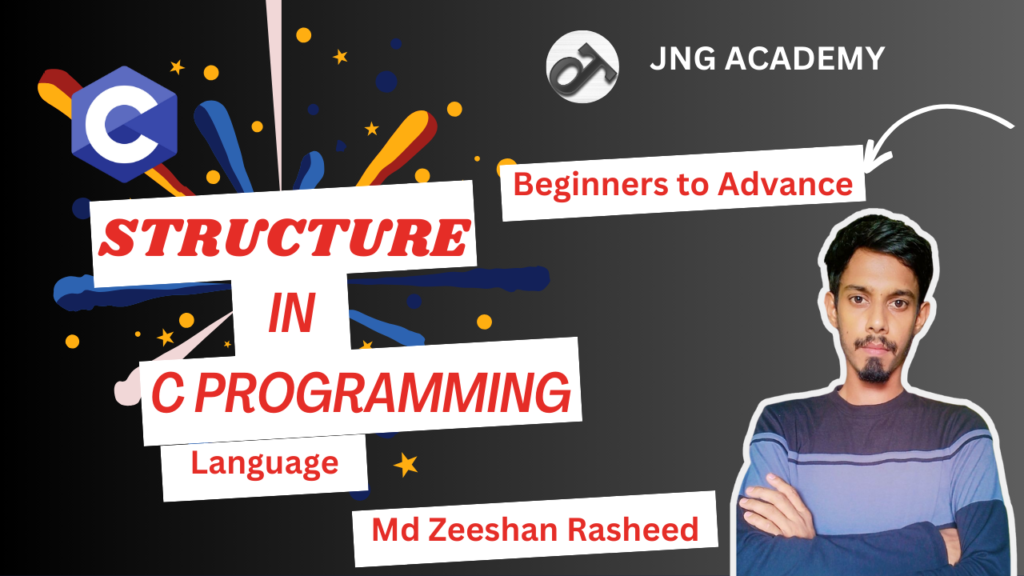Structure in C Programming Language: In C programming, a structure is a user-defined data type that allows the combination of different data types (int, float, char, etc.) under a single entity. It is particularly useful when dealing with data that requires grouping, such as representing information about a person (name, age, address) or an item in a database (product ID, price, and description). Unlike arrays, which store similar data types, structures allow the storage of varied data types in one composite format.
C Programming Video Tutorial Lecture-02
Table of Content
What is Structure in C Programming Language
Structures in C provide a powerful way to group variables of different data types together, enabling you to model real-world data more effectively. By understanding how to define, access, and manipulate structures, you’ll be better equipped to handle more complex data in your C programs.
It is a collections of hetrogenous types of data.
It is keyword in c programming language to create structure i.e., struct keyword.
It is a user defined datatype.
Example:
struct student{
int Roll;
char name[20];
}
The above code is only called declaration or blueprint or template.
Here, No any momory will be allocated.
int main(){
struct student s1, s2;
}
The above code contain struct student is a data type or user defined data type and s1 & s2 is a veriables.
If we need to access a perticular number of a group we need to specify the group name.
Note: Membership Operator: ‘ . ‘
Example of Structure in C Programming Language
struct student {
int Roll;
char name[20];
}
int main(){
struct student s1, s2;
s1.Roll = 5;
s2.Roll = 15;
}

Declaring a Structure in C Programming Language
To declare a structure in C, use the struct keyword followed by the structure definition:
struct structure_name {
data_type member1;
data_type member2;
// More members can be added here
};
Here, structure_name is the tag that will be used to refer to the structure, and member1, member2, etc., are the fields or members of the structure.
Example of Structure in C Programming Language
struct Person {
char name[50];
int age;
float height;
};
This example defines a structure Person with three members: name, age, and height.
Accessing Members of Structure in C Programming Language
Once a structure is defined, you can create variables of that type and access the structure members using the dot (.) operator.
Example of Accessing Members of Structure in C Programming Language
struct Person person1;
person1.age = 25; // Accessing and setting the age member
strcpy(person1.name, “John Doe”); // Setting name using strcpy
person1.height = 5.9; // Setting height
printf(“Name: %s\n”, person1.name);
printf(“Age: %d\n”, person1.age);
printf(“Height: %.1f\n”, person1.height);
Initializing a Structure in C Programming Language
You can initialize structure members at the time of declaration:
struct Person person2 = {“Alice”, 30, 5.7};
This creates a Person structure variable person2 and initializes its members with the values “Alice”, 30, and 5.7.
Array of Structure in C Programming Language
You can also create arrays of structures, allowing you to store multiple instances of a structure.
Example of Array of Structure in C Programming Language
struct Person people[3] = {
{“John Doe”, 25, 5.9},
{“Alice”, 30, 5.7},
{“Bob”, 22, 6.0}
};
You can access individual elements using array indexing, for example:
printf(“First person: %s, %d, %.1f\n”, people[0].name, people[0].age, people[0].height);
Pointer to Structure in C Programming Language
Just like other data types, pointers can be used with structures. To access structure members using a pointer, you use the arrow (->) operator.
Whenever we have a pointer to structure then instead of doing (*ptr).a to access numbers named, we can also use arrow (->) operator.
ptr -> a equivalent to (*ptr).a
ptr -> b equivalent to (*ptr).b
Example of Pointer to Structure in C Programming Language
struct student{
char name[20];
int Roll;
}
int main(){
struct student s = {“Zee”, 1};
display(&s);
}
void display (struct student *ptr){
printf(“%s”, ptr -> name);
printf(“%d”, ptr -> Roll);
}
Example of Pointer to Structure in C Programming Language
struct Person *ptr, person3 = {“Emily”, 28, 5.8};
ptr = &person3;
printf(“Name: %s\n”, ptr->name);
printf(“Age: %d\n”, ptr->age);
printf(“Height: %.1f\n”, ptr->height);
Here, ptr is a pointer to the structure person3, and we use the -> operator to access the structure members.
Nested Structure in C Programming Language
Example of Nested Structure in C Programming Language
struct Address {
char street[50];
char city[50];
int zip;
};
struct Person {
char name[50];
int age;
struct Address address;
};
Here, the Person structure contains a nested Address structure.
Accessing Members of Nested Structure in C Programming Language
struct Person person4 = {“Michael”, 40, {“123 Main St”, “New York”, 10001}};
printf(“Street: %s\n”, person4.address.street);
printf(“City: %s\n”, person4.address.city);
printf(“ZIP: %d\n”, person4.address.zip);
Advantages of Structure in C Programming Language
- Organizing Data: Structures allow the grouping of different data types, which improves code readability and management.
- Flexibility: Structures provide flexibility to create complex data types that can represent real-world entities.
- Memory Efficiency: Since structures don’t need extra memory for each member individually, they can be more efficient than arrays of different data types.
Frequently Asked Questions (FAQs)
What is the difference between a structure and an array in C?
Can we have an array of structures?
How are structures different from classes in object-oriented programming languages like C++?
Can a structure contain another structure?
Is it possible to pass structures to functions in C?
Learn More
Subscribe “JNG ACADEMY” for more learning best content.
Important Links
C Programming Language Lecture-01
C Programming Language Lecture-02
C Programming Language Lecture-03
C Programming Language Lecture-04
C Programming Language Lecture-05
C Programming Language Youtube Playlist
Thank You So Much, Guys… For Visiting our Website and Youtube.
